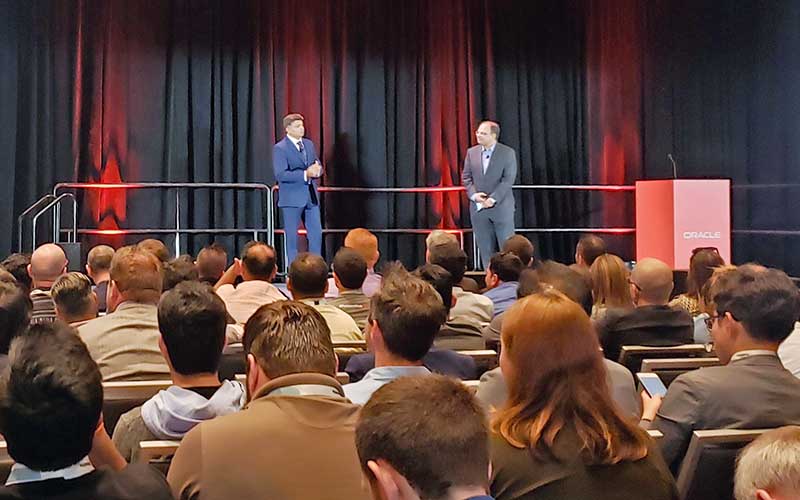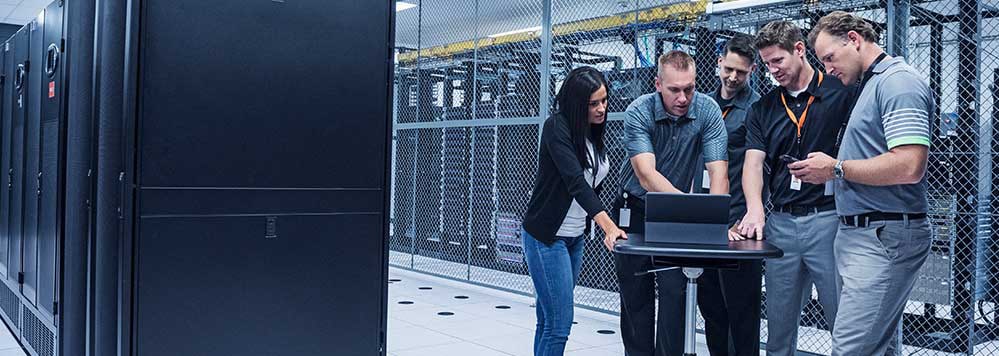Business Transformation for Discrete Industries
Infosys and Oracle are committed to helping clients transform during their digital journey. We do this by providing fresh perspectives, empowered talent and unique commercial models that help our clients increase efficiency, maximize productivity and continuously improve their user experience.
Digital disruption in manufacturing has been at the forefront of industry conversations as analog has moved into a digital world. The disruption has also led to new business models, more opportunities and better customer interaction. Those much-needed outcomes enable change and collaboration as businesses transform.
“We are in an era of profound change, a massive change that is happening, which is unprecedented,” said Raghu Boddupally, AVP and Delivery Head, Oracle Practice, Infosys. “Only a few decades back, the average life span of a Fortune 500 firm was 75 years. That’s come down drastically to 15 years. While everyone has heard this statistic, it is truly amazing when you consider its implications and opportunities.”
Those life span figures are expected to decrease by half in the next decade, highlighting the magnitude of disruption manufacturing will continue to experience. Like other industries, it is seeing change across the board, yet studies show that few companies are addressing this purposefully and backing the change, or generating innovations that leverage technology advances to thrive in the chaos.
“We typically associate technology adoption with transformation in an industry,” Boddupally said. “While technology plays a pivotal role in a transformation, what really drives transformation are market drivers and the emerging market needs.”
Business transformation drivers in manufacturing include macroeconomic factors like labor rate, oil, and currency shifts. Those elements certainly played a role in Western Digital’s foundational transformation.
“When we started our ERP journey, we made master data management a critical part of every phase of our ERP transformation,” said Senthil Thirunavukkarasu., Sr. Director IT for Western Digital. “Today, we are almost two and a half years after we started our Oracle cloud journey. In each phase, we started with finance, then we implemented MDM, so we have all of our finance master data in the cloud.”
Western Digital is a combination of three companies: Western Digital Legacy, Western Digital and SanDisk, and Hitachi Global Storage Technologies. Their strategic IT initiatives moved the company from a legacy system to an Enterprise Resource Planning transformation system during a four-year plan.
“Now we have all of our suppliers in cloud procurement,” Senthil said. “All of our customers are now in a single repository. We had to harmonize each of these in master data before we could move them to the cloud platform.”
Oracle has released cloud technology that presents a level, more robust playing field for small and large businesses. There are different ways to approach this process.
“We did not have a single process; we had multiple,” Senthil said. “Even though it was three companies, even within the legacy companies, there were several M&As going on in the past few years in the storage industry. We had to start with multiple processes.”
There were a lot of organizational changes that required a four-year roadmap to move the integrated company to Oracle cloud.
“We started with establishing high-level processes,” Senthil said. “We first had to establish some governance, and we made use of our operating committee. Change management was very important; security was very important, so was management training.”
There are heightened regulatory challenges, along with compliance around sustainability and business conduct, which further challenges companies that are seeking to increase market share. Higher oil prices and some other economic factors are also significant market drivers.
“If you look at it from a technology perspective, some of these technologies, such as sensing, interfacing and material, are changing the face of manufacturing in ways unbelievable just a few years back,” Boddupally said.
Now, data is driving artificial intelligence and predictive analytics. This capability allows manufacturers to predict and get detailed, real-time views at each step of the manufacturing process, helping leaders create new business models.
“3D printing is moving beyond the pilot and the POC stage, and they are actually getting into production. There is a lot more adoption,” Boddupally said. “With the combination of these manufacturing drivers and technology enablers, newer business models are evolving.”
World Wide Technology is one of the companies evolving and influencing digital roadmaps by providing companies with connectivity solutions. Customer demands prompted the company to move away from a traditional application approach.
“World Wide has 175 customers that we serve in high technology services, hardware services and value-added services,” said Mukesh Baldua, Enterprise Architecture leader at World Wide Technology. “Demands of each and every customer have been quite varied over a period of time, and they’ve been growing very rapidly.”
The company embarked on a journey to the cloud, avoiding a waterfall approach, to enable the organization’s transformation. Company officials discovered that cloud infrastructure was the one thing that brought data and connectivity together.
Vertiv, a leader in computing infrastructure, follows that same thought process and is known as the architect of continuity. Vertiv’s data center expedited their own digital transformation. While not one of the largest cloud consumers, the company is a big adopter of Oracle cloud capabilities.
“We adopted almost all the SaaS [software as a service], PaaS, and services, as well as the capability,” said Mohamed Ayadi, senior director at Vertiv. “The goal was to bring that all together and rationalize what we have, and not have to replace everything, to not disrupt the business or integration. The Oracle integration cloud became a critical piece of technology that brought the legacy and the future state to meet the business need in an agile manner. Also, to meet our go-to-market goals, and budget needs as well, because it’s critical to the digital transformation.”
The first wave of their digital transformation was for warehouses, which were located across the U.S., Singapore, and Ireland. The company connects devices in their warehouses, as well as the scanning devices used for packing and shipping. Connecting all this to Oracle SaaS Fusion, PaaS, and RF-SMART (a SaaS vendor) was a complex, risky endeavor.
“By the end of this year, we’ll be connecting to 50,000 devices to collect thermal and power data, to enable predictive maintenance of our modern data center and improve availability,” said Ayadi.
The manufacturing industry is going through a revolution, and the pace of innovation is increasing. To improve the product means improving the process, and a system collaboration model has the greatest potential to realize success.
Transform to a Live Enterprise
The complexities of running an enterprise have increased with newer disruptive business models, the data explosion, hyperpersonalization and extreme automation. As a result, enterprises are looking to become nimble, change quickly and become more productive. Companies are also advancing their digital transformation to adapt to rapid changes in markets, business needs and consumer preferences — in other words, to become a Live Enterprise.
How can an enterprise learn from nature? How can it sense, respond and act as a living organism while navigating the twists and turns of a complex business world? Those are the core questions leaders must address. Those are also a few of the questions discussed during the executive forum at Oracle OpenWorld. The panel topic focused on navigating through digital and cloud journeys to transform to a Live Enterprise.
“We are converting ourselves into a Live Enterprise,” said Gopikrishnan Konnanath, senior vice president Infosys. “Live Enterprise runs across the ecosystem, which includes learning, knowledge management and outreach to our customers so that we have actual live data available for any of us at any time.”
There are three elements necessary for a Live Enterprise: rapid evolution of technology, talent ready for change and the assurance that all will go as planned when moving from one point to another.
“The process, methodology and metrics you use are all very important; but most important is the culture of the organization and the changes that the organization needs to undergo as it transitions into a Live Enterprise,” Konnanath said.
Konnanath suggested that the culture of any organization must change in order for it to transition to a Live Enterprise. However, leaders must make sure the core value system and beliefs remain the same. Leaders must make incremental changes to adapt to the changes that are happening in the industry.
Three leaders from various industries have experience in making these suggestions a reality. Connie Santilli, Vice President Enterprise Systems and Strategy & Emerging Markets, GAP Inc.; Jeff Schick, senior vice president, North America cloud sales, Oracle; and Ben Wiener, CEO of WONGDOODY, all understand the value of using these core values in their respective industries.
The retail industry is going through a great deal of change — in pricing, outreach to consumers, and global rules and regulations. Investing in the right technology is necessary for continuous innovation.
“We have started moving our platforms to the cloud,” said Connie Santilli. “It has been a very big key strategic initiative for us at Gap. We started several years ago with the idea that we wanted to make sure we could find a way to get out of managing data centers. We were running about six at that time, and we really wanted to focus on our core competency, which is making apparel to delight our customers.”
Gap Inc. is a pioneer in technology. It is the first customer to use the Oracle retail SAS, and it is also doing multiple transformation initiatives. Even though Gap Inc. has sent some of its workload to the cloud, it is still running databases and Oracle applications along with other cloud platforms.
“We wanted to leverage those, to be able to free up our resources and time and bandwidth to be able to focus on the things that were most important to us in terms of innovation,” Santilli said. “This now sets the ground and the framework for us as we separate our two companies, Old Navy and Gap. We’re in the process of separating for next year to get us into platforms that will really be scalable for them to build and innovate on.”
Moving into the enterprise resource planning era and into cloud ecosystems and new generation technologies, companies are moving from an era of extreme standardization to, probably, a future of extreme personalization. That journey leaves several questions that must be answered.
“How do you augment? How do you improve?” asked Jeff Schick, Oracle. “How do you create innovation on the technology that you’ve deployed that doesn’t support the interfaces that allow it to be open? And so, the journeys allowed that to happen in our premises, but now as you evolve to cloud, and you’re embracing a SAS-based solution, am I able to do that same level of customization, am I able to provide the same level of integration services that became accustomed to our on premises? And I see a true evolution going on in terms of how that happens.”
Schick went on to say the changes are not just a matter of lifting and shifting ideas but taking solutions, opening them up and doing things with them that seem impossible. The opportunity and the way technology is evolving create a level of flexibility that allows users to customize or augment or innovate on the platform, along with the ability to do it in the cloud as well.
“And so, as we’re working with clients at a leading investment banking firm, we’re in the position of taking human capital management and then augmenting that through innovation,” Schick said. “Whether it be mobile services or human-centric interfaces where you can talk to the workflow or something along those lines.”
The technology perspective and the industry perspectives won’t work if the consumer is not in the equation. Schick reminds us of the concept of getting the consumer into the industry and creating zero distance between the consumer and the industry. This can only happen through experience in terms of attracting people into something new. However, achieving that goal is a challenge.
“What’s interesting is everybody talks about experiences, but they tend to talk about experiences in silos,” said Ben Wiener, WONGDOODY. “Here’s an employee experience, here’s a customer experience, here’s an experience that happens in a physical retail store, here’s an e-commerce experience. Consumers don’t look at it that way.”
He said industry professionals look at the situation that way because that’s how companies organize, or they use different software applications.
Another aspect of the Live Enterprise transformation, one of the largest elements, is the change management that companies undertake within an organization.
“It starts with the executive leadership,” said Santilli. “They have to set the strategy, the vision, the culture, and to get everybody aligned. Then it trickles down. So, we had that at the onset a couple of years ago in terms of the transformation we wanted to undertake.”
She says it takes some time to get a team together. Leaders have to make sure employees start to understand what’s going to happen to their jobs, to see how exciting it is going to be for that employee and his or her development.
“So, you have to foster a culture in which employees can thrive, to make it fun and interesting for them, and to give them space to be creative and flexible so that they buy into it because it’s great for them as well,” said Santilli. “While you can have free lunches and things like that, which are great, I think the way we’re able to keep talent and to keep them excited is to have this really great work that they’re excited about doing and seeing how it elevates them and their self-fulfillment and in how it fulfills the goals of the company.”
Companies do what people call repurposing and refactoring of talent. The behavior of traditional STEM graduates , for instance, is not changed, but the internal structure is improved. Refactoring creative people is more inherent than being trained.
“I think when organizations are going for a change, a change as large as moving into digital, as large as what you’re doing at Oracle in terms of the whole evolution of cloud and digital,” Konnanath said, “I think it is required to have leadership of the quality that will actually guide people when they’re wrong into the right direction, and make them look good. It is important to have a culture where passion supersedes the fear of failure.”
Tokenization using Oracle Blockchain Platform
Blockchain’s ability to share information across multiple organizations in real time makes it an increasingly popular business tool. No longer a technology of the future, it’s already showing potential in supply chain management, trade finance, insurance and even cybersecurity.
Mark Rakhmilevich, Oracle’s senior director of blockchain product management, told an audience at Oracle OpenWorld 2019 that the technology can help streamline processes, facilitate automation and track something as basic as cooking oil.
“You rely on data that comes from other parties,” Rakhmilevich said about the difficulty of tracking products. “You have to be able to integrate the data with your data.” Those file transfers, spreadsheets, emails and other data “open up the possibility for human error [and] fraud,” he said.
Blockchain can be reduced to a relatively simple definition: an immutable, distributed ledger. However, its implementation in the business world is complex, featuring many layers and parties.
As blockchain gains traction beyond cryptocurrencies, organizations are confronted with a growing number of enterprise options, including public, private and a hybrid of both.
“Bitcoin is basically where the public blockchains typically are,” Rakhmilevich said. “Then the technologies they use on the enterprise side include Hyperledger Fabric or Sawtooth, Corda, or Quorum, which is sort of a permission version of Ethereum.”
The primary benefit of blockchain is that the ledger data comes from multiple sources to prevent tampering. Also, blockchain smart contracts can expand the opportunities for automation. Combined, this process can
Reduce human error and fraud.
Eliminate some intermediaries.
Reduce costs and fees.
With Oracle’s blockchain platform, Rakhmilevich said, “Customers can apply the process across bank transactions, leveraging blockchain and leveraging the blockchain adapters. Plugins are available for integration adapters for different Oracle SAS applications as well as on-premises applications and even non-Oracle applications. So, whether you’re using your e-business suite for ERP or SAP or Workday for HR staff, there is an adapter available.”
One real-world example of how this works is the case of Palm Oil provenance. Consumer product companies have long stated the need to source 100% certified sustainable palm oil. Companies are struggling to trace the origin of its palm oil due to the lack of infrastructure and technology where the product originates. The challenge is knowing the details of the fruit, the location of the harvest and the quality of the land. The key to achieve this goal lies in the hands of the farm to mill value chain producing the oil. A Big Manufacturing, Agribusiness and Advisory services is considering building Blockchain powered platform for sustainable palm oil production for independent smallholders in Indonesia. The provenance of palm oil is also important because of its role in deforestation and air pollution in some areas.
Using blockchain technology, digitized data on the fresh fruit bunches can be tracked in a trustworthy and future-ready manner. Artificial intelligence and other advanced technology is used to recognize, differentiate and monetize the produce. This proof of concept, implemented in three months, benefits the farmers, traders, purchasers and shareholders,” said Gurdeep Kalra, a principal consultant at Infosys.
He described Oracle blockchain as an effective “track and trace” method for farmers in Asia and their buyers. “They can see which land is being used and how big the harvest is — and it’s instantaneous,” he said. “There is no minimum waiting time, which is important because after 48 hours, the fruit quality starts going down.
Understanding the entire process can also ensure that the cultivation of crops doesn’t lead to deforestation, Kalra explained. To do this effectively, assets must be tokenized.
“Tokenization is a process of converting any asset into a value that we can trade and that can be moved along the blockchain,” Kalra said.
This process encourages digitization, starting with the farmers. Kalra said Indonesian farmers had been manually recording their information but now are moving toward a mobile-centric approach.
With the creation of a digital wallet, the ability to add and subtract points or coins is necessary. As the mill owner transfers material, a digital wallet system allows the farmer to receive payment and stream all the upgrades into the blockchain ledger. This adds flexibility to the payment process.
An Oracle database streams the data, while the cloud is utilized to build reports. Machine learning is utilized by an autonomous database. That part of the program takes just an hour to set up for basic use.
A lot of customers benefit from having the kinds of capabilities that Oracle brings to the table, because everybody is still experimenting.
Oracle Cloud Infrastructure solution

Oracle databases have become the backbones of businesses worldwide since the software’s introduction 40 years ago. While that remains constant, the market now extends far wider than just providing software to corporations.
Company officials announced a variety of new services, cloud options and other features at Oracle OpenWorld 2019 recently. There are new cloud regions, in-country disaster recovery, ecosystems, partnerships and other developments in the world of cloud infrastructure solutions.
“We’re not just focused on any single vertical,” said Clay Magouyrk, Oracle’s senior vice president of software development. “We’re going after different databases. We’re going after different analytics, and ML [machine learning] and HPC [high performance computing] offerings. Across the entire stack, we’re working with as many partners as possible to make sure they’re certified. The ultimate goal is to make sure the software works well on top of Oracle cloud infrastructure (OCI).
Magouyrk, a keynote speaker, told the audience that Oracle is launching a new approach to computing and block storage: a cafeteria-style way of assembling a system. The new approach will allow companies to select a computer, choose the number of cores and amount of memory, and then pay only for the services used.
“If you want to take options away, you can take them away,” Magouyrk said. “If you want to increase your memory, you should be able to do that all while your VM [virtual machine] is still running.”
Cloud service is now a mainstay of the business at Oracle, with free trials and introductory credits becoming regular features.
“Now you get a couple of autonomous databases,” he said. “We have a scaled-down compute offering. We’re giving a free load balancer, etc. The idea behind this is that with this set of technology for free forever, you can build real applications on top of the Oracle cloud.”
Dinesh Rao, Infosys’ executive vice president, head of global services for enterprise package application services, explained how this all filters down to applications, updates and the journey into Oracle Cloud Infrastructure.
Businesses are looking to reduce operational expenses, so capital is increasingly used to adopt new technology, Rao said. When organizations reduce IT structure, it can move toward more connectivity and “Live Enterprise.”
“This digital transformation is driving business outcome toward moving organizations to become more agile and more nimble,” Rao said. “We’re looking at newer business models, looking at how to declutter the entire business landscape that we have built.”
In the past two decades, Infosys has worked closely with Oracle across the entire spectrum of its offerings, from business consulting to technology to databases.
“What this brings to the table is the 20 years of our hard-earned credibility, knowing what Oracle applications do, what their technology footprint is, and what it takes for us to help a very seamless migration journey toward the OCI,” Rao said.
Several factors are needed to make this process work, including the awareness that every migration case is unique. This process works best when Infosys and Oracle collaborate to create an optimized solutions architecture with a laid-out migration strategy. The result? A seamless migration into OCI and meeting the deadline to market.
Another major factor is building tools and accelerators — including artificial intelligence — to make sure that all areas are automated. That helps reduce the total cost of ownership by more than 30% and, most importantly, assists in meeting the agreed-upon timelines.
Experience is also a crucial factor, said Rao. Infosys was Oracle’s first managed services provider partner. “This provides a unique joint partnership,” he said, where Infosys can “bundle all the licenses, your hardware cost as well as services that you create.”
U.S. financial services company TIAA recently embarked on that Oracle cloud journey: 16 months from concept to contract and cloud. Some executives described it as a necessary one for the organization’s survival.
Mangesh Deo, a senior director and executive app development manager at TIAA, said a key issue the company considered was security. In traditional databases, organizations had to constantly search for vulnerabilities and keep software patched. With cloud, Deo said. “We could make sure that becomes Oracle’s headaches.”
On top of the security benefits, this transition also offered scalability and reliability at a good price.
“Not only are we offering to migrate the applications onto Oracle cloud, but the business drivers are reducing the run cost, running your applications and reducing the cost,” Rao said.
Rao Mettu, principal technology architect at Infosys, said he offers innovative bundles that include application management services, application licenses and hosting services.
“Businesses will not have any problem,” he said about the migration to Oracle cloud infrastructure. “We’re trying to do a lift and shift of these applications, whether it’s an EBS, PeopleSoft, OBIE, JD Edwards or you name it. All the enterprise applications we do it … no impact on the business, but then you’re going to save your costs.”
With application modernization, there is also added speed so cloning and response times will be reduced. In addition, Mettu said, “Your bad jobs are going to run much, much faster.”
The migration to Oracle cloud also reduces workload and improves performance.
“We bring in a lot of scalabilities, agility, license optimization, reduce our AD cost of your skill sets,” he said.
Mettu said the results of using this extensive migration system on an Oracle cloud infrastructure is easy to measure. Today’s customers need the flexibility and the ability to make changes without incurring downtime. In other words, the customer is happy, and the cost of business is lowered in the process.
Model critical design patterns with Oracle Integration
Many organizations still take a traditional approach to technology and run large numbers of their applications on-premises. However, business features are incrementally moving to the cloud, making this transition more desirable, said Ramkumar Menon, Oracle’s director of product management.
On average, midsize to large organizations have more than 75 applications — including enterprise and social productivity — operating in the cloud. Technology advances are providing new opportunities to move off-premises while creating fewer drawbacks in the process.
Some products operating on Oracle Cloud have the capability to run behind a customer’s firewall and use third-party cloud services, turning Oracle into a multicloud operating system. The integration products also enable customers to design their APIs to meet business needs and to implement data services through APIs.
“There’s a need to connect back to their on-premises systems, to connect with their applications and to modernize the business processes, including the use cases such as employee onboarding,” Menon told an audience at Oracle OpenWorld 2019. “What do you do when you hire an employee? Connecting the security system into the LDAP [lightweight directory access protocol] system, badging and connecting the employee directory to your payroll, and human resource management, all the way to opportunity and sales pipeline management.”
Beyond that, Menon said, there are a wide variety of applications that can be connected through native adapters. He said the products can connect to Oracle, SaaS on-premises, open APIs and technology adapters, including file FTP, JWS, JMS, M and databases.
As with most technological advances, this is not a simple process. Menon said organizations must work hard to learn the products’ capabilities so they can execute faster while eliminating errors. Also, organizations must ask critical questions to ensure they are moving in the right direction.
“Customers are always thinking in terms of ‘whether this capability will serve all my purposes,’” said Amol Kulkarni, senior technology architect at Infosys. “‘How will I live with my legacy stack? How can I leverage my investment? Is this the correct product for me?’”
His team’s mission includes ensuring that customers are prepared for their challenges. Every enterprise will have its own specific hurdles, Kulkarni said.
“We have to tailor the integration architecture to support their own business cases and their solutions and problems,” he said.
An operational excellence team is needed to ensure that when the implementation is going on — as well as when it is complete — operations continue smoothly and normal support processes are enabled, Kulkarni said. Those processes include the dashboard, alerts and active monitoring.
Another focal point is more innovation and overcoming challenges seen in the existing legacy stack.
“The objectives of migrating or enabling the digital transformation journey are not only getting the business benefit of using the harmonization of business processes,” Kulkarni said, “but also making sure that we address the gaps on the technical side of the integration.”
He went on to address several other aspects of the transformation program, such as finding a platform that will support the next generation. He noted that some objectives include looking for a common standard design template.
“They want a platform that should have a capability to support the considerable integrations,” Kulkarni said. “One of the key objectives of any digital transformation program is to use out-of-the-box [solutions]. People want to leverage the cloud benefit of day one because on day one you have a SaaS adapter available.”
Kulkarni said companies don’t want to live with multiple technology platforms that require different skill sets. This adds to the cost and time required to reskill employees who must deal with the various technologies and multiple support teams.
“As part of the journey, they were able to find out ‘how I can merge this workflow within the application stack,’” Kulkarni said, referring to one case study. “That is where integration cloud comes into play.” There are features and benefits that can showcase the platform’s benefits to leaders.
“I can have a consolidated platform that supports most of these technological aspects,” Kulkarni said. “Every enterprise will need an API gateway for the external communication to have a high-secured transaction or standardize it as a service and make it enabled for customer use.”
“These are the basic asks of any enterprise integration for applications: human workflow, messaging, custom extension supports,” he said. “These are the capabilities. There are multiple products available in the market.”





